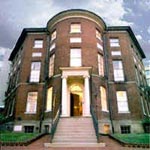THE MILLENNIAL BICENTENNIAL
The turn of the century was overshadowed by celebrations of the millennium - except in places where "'tennials" were being observed. Our ongoing feature highlights what was truly a turning point in American history.
STORIES

The Octagon Bicentennial
Taken as a whole, Bicentennial celebrations bring to light what was happening around the country two hundred years ago. In 1801, Thomas Jefferson had just been elected in the hottest political contest the new nation had ever seen. Several of the "midnight judges" appointed by John Adams did not make it through confirmation - but John Marshall was in firm charge of the U.S. Supreme Court, beginning a long career that would assert and solidify the power of the federal judiciary.
Our nation's new capitol was itself still very much under construction. The boundaries and administration of the District of Columbia were still being defined, and part of the original grant went back to the state of Virginia, as Arlington County. As Thomas Jefferson laid out the White House gardens, many new buildings were going up - including the first U.S. Marine Corps barracks and an unusual private dwelling called The Octagon, that would later provide emergency housing for President Madison.
Elsewhere in the old Eastern seaboard states, many people were packing up and moving on. A group of Vermont Quakers followed new roads and waterways into the Great Lakes and formed Newmarket in Ontario. Others were building towns on the national frontier in Maine, Georgia, central Pennsylvania, New York, Kentucky, Tennessee, and Eastern Ohio.
Families were being split apart and old traditions and hierarchies were breaking down. It was a time of democracy, dislocation and individual uncertainty. Many reached out for the stability and the inspiration of religion. Frontier churches formed and at Cane Ridge, Kentucky a great camp meeting culminated in a weekend of conversions that were reported around the world - beginning what historians today call the Second Great Awakening. Meanwhile, a small group of Freemasons was gathering at Charleston to form a new society based on ancient traditions.

West Point Bicentennial
America could not compare with Europe in art, science, or war. In fact, many of our young artists and inventors went abroad, seeking training, support and a better climate for their work. But new institutions of higher learning were forming, including the University of South Carolina, and the U.S. Military Academy at West Point.
